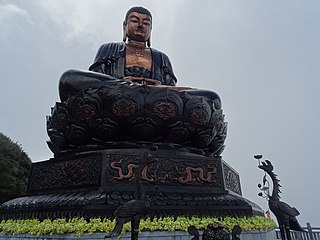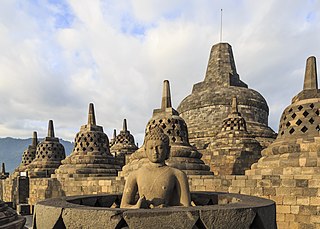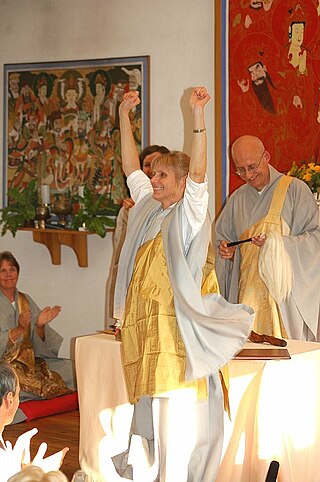See also
![]() Media related to Buddhism in Slovakia at Wikimedia Commons
Media related to Buddhism in Slovakia at Wikimedia Commons
Buddhism is not officially recognized as a religion in Slovakia. As of January 2021, Buddhists numbered 6,722 or 0.12% of the population. [1]
Various Buddhist schools, including all three traditional vehicles (Theravada, Mahayana and Vajrayana), are active as either informal groups or civil associations. Theravada is represented by groups of vipassana practitioners. Several Zen schools, including disciples of Sando Kaisen, and the Korean Kwan Um School, represent the Mahayana. Vajrayana schools include Nyingma practitioners following Namkai Norbu Rinpoche. The Diamond Way organisation founded and directed by Ole Nydahl is also active in Slovakia.
After World War II, Czechoslovakia (later to be known as Slovakia) was reconstituted as a socialist state and religious freedoms were restricted. Article 32 of the 1960 Constitution of Czechoslovakia established the freedom of religion for individuals. [2] Along with immigration and globalization, the number of Buddhists and influence of Buddhism in Slovakia slowly increased. However, the influence and spread of Buddhism remained obscure as adherents amounted to less than 1% of the population. [1] Buddhism has been acknowledged in Slovakia, however, and leaders of Buddhist traditions have been welcomed. In 2016, president of Slovakia Andrej Kiska met with the Dalai Lama in Bratislava and described it as a “privilege” to meet with the Tibetan spiritual leader. [3]
According to the 2021 census, the number of adherents to Buddhism numbered 6,722 or 0.12% of the population. [1] Buddhism is not recognized as a state religion in Slovakia as it does not meet the requirement of at least 50,000 adherents, and is thereby registered as a civic association. [4] In 2022, the Public Defender of Rights (ombudsperson) stated that the registration requirements were unreasonable, discriminatory, and unnecessary; the Ministry of Culture refused to initiate a legal change. [5]
![]() Media related to Buddhism in Slovakia at Wikimedia Commons
Media related to Buddhism in Slovakia at Wikimedia Commons

Tibetan Buddhism is a form of Buddhism practiced in Tibet, Bhutan and Mongolia. It also has a sizable number of adherents in the areas surrounding the Himalayas, including the Indian regions of Ladakh, Sikkim, and Arunachal Pradesh, as well as in Nepal. Smaller groups of practitioners can be found in Central Asia, some regions of China like Xinjiang, Inner Mongolia, and some regions of Russia, such as Tuva, Buryatia, and Kalmykia.

Vajrayāna, also known as Mantrayāna, Mantranāya, Guhyamantrayāna, Tantrayāna, Tantric Buddhism, and Esoteric Buddhism, is a Buddhist tradition of tantric practice that developed in Medieval India and spread to Tibet, Nepal, other Himalayan states, East Asia, parts of Southeast Asia and Mongolia.

The schools of Buddhism are the various institutional and doctrinal divisions of Buddhism which are the teachings off buddhist texts. The schools of Buddhism have existed from ancient times up to the present. The classification and nature of various doctrinal, philosophical or cultural facets of the schools of Buddhism is vague and has been interpreted in many different ways, often due to the sheer number of different sects, subsects, movements, etc. that have made up or currently make up the whole of Buddhist traditions. The sectarian and conceptual divisions of Buddhist thought are part of the modern framework of Buddhist studies, as well as comparative religion in Asia. Some factors in Buddhism appear to be consistent, such as the afterlife. Which differs on the version of Buddhism.

Buddhism includes a wide array of divine beings that are venerated in various ritual and popular contexts. Initially they included mainly Indian figures such as devas, asuras and yakshas, but later came to include other Asian spirits and local gods. They range from enlightened Buddhas to regional spirits adopted by Buddhists or practiced on the margins of the religion.
The history of Buddhism can be traced back to the 5th century BCE. Buddhism arose in Ancient India, in and around the ancient Kingdom of Magadha, and is based on the teachings of the renunciate Siddhārtha Gautama. The religion evolved as it spread from the northeastern region of the Indian subcontinent throughout Central, East, and Southeast Asia. At one time or another, it influenced most of Asia.

Buddhism is the second largest religion in Malaysia, after Islam, with 18.7% of Malaysia's population being Buddhist, although some estimates put that figure at 21.6% when combining estimates of numbers of Buddhists with figures for adherents of Chinese religions which incorporate elements of Buddhism. Buddhism in Malaysia is mainly practised by the ethnic Malaysian Chinese, but there are also Malaysian Siamese, Malaysian Sri Lankans and Burmese in Malaysia that practice Buddhism such as Ananda Krishnan and K. Sri Dhammananda and a sizeable population of Malaysian Indians.

This list of Buddhism by country shows the distribution of the Buddhist religion, practiced by about 535 million people as of the 2010s, representing 7% to 8% of the world's total population. It also includes other entities such as some territories.

Buddhism in Nepal started spreading since the reign of Ashoka through Indian and Tibetan missionaries. The Kiratas were the first people in Nepal who embraced the Buddha’s teachings, followed by the Licchavis and Newar people. Buddhism is Nepal's second-largest religion, with 8.2% of the country's population, or approximately 2.4 million people, identifying as adherents of Buddhism in a 2021 census.

With nearly 250,000 Buddhists, Brazil is home to the third-largest Buddhist population in the Americas, after the United States and Canada. Buddhism in Brazil consists of practitioners from various Buddhist traditions and schools. A number of Buddhist organisations and groups are also active in Brazil, with nearly 150 temples spread across the states.

Buddhism in Vietnam, as practiced by the Vietnamese people, is a form of East Asian Mahayana Buddhism. It is the main religion in Vietnam. Vietnamese Buddhism is generally inclusive and syncretic, drawing on the main Chinese Buddhist traditions, such as Tiantai and Huayan, Zen (Thiền), and Pure Land.

Buddhism has a long history in Indonesia, and it is one of the six recognized religions in the country, along with Islam, Christianity, Hinduism and Confucianism. According to 2023 estimates roughly 0.71% of the total citizens of Indonesia were Buddhists, numbering around 2 million. Most Buddhists are concentrated in Jakarta, Riau, Riau Islands, Bangka Belitung, North Sumatra, and West Kalimantan. These totals, however, are probably inflated, as practitioners of Taoism and Chinese folk religion, which are not considered official religions of Indonesia, likely declared themselves as Buddhists on the most recent census. Today, the majority of Buddhists in Indonesia are Chinese and other East Asians, but small communities of native Buddhists also exist.

Buddhist vegetarianism is the practice of vegetarianism by significant portions of Mahayana Buddhist monastics and laypersons as well as some Buddhists of other sects. In Buddhism, the views on vegetarianism vary between different schools of thought. The Mahayana schools generally recommend a vegetarian diet, claiming that Gautama Buddha set forth in some of the sutras that his followers must not eat the flesh of any sentient being.

Buddhism in Southeast Asia includes a variety of traditions of Buddhism including two main traditions: Mahāyāna Buddhism and Theravāda Buddhism. Historically, Mahāyāna had a prominent position in the region, but in modern times, most countries follow the Theravāda tradition. Southeast Asian countries with a Theravāda Buddhist majority are Thailand, Cambodia, Laos, Myanmar, all of them mainland countries.

Women in Buddhism is a topic that can be approached from varied perspectives including those of theology, history, anthropology, and feminism. Topical interests include the theological status of women, the treatment of women in Buddhist societies at home and in public, the history of women in Buddhism, and a comparison of the experiences of women across different forms of Buddhism. As in other religions, the experiences of Buddhist women have varied considerably.

With a rough estimate of 6100 Buddhists, Buddhism is practiced by around 0.05% of the Czech population. The World Buddhist Directory lists 70 Buddhist places in the Czech Republic.
Myanmar (Burma) is a Buddhist majority country with a significant minority of Christians and other groups residing in the country.
Nepal is a secular state under the Constitution of Nepal 2015, where "secular" means religious, cultural freedoms, including protection of religion and culture handed down from time immemorial.

In the Czech Republic, 47.8% of population is irreligious, while 21.3% of the population are believers. The religious identity of the country has changed drastically since the first half of the 20th century, when more than 90% of Czechs were Christians. As of 2021, 11.7% of the population identified with Christianity whilst 10.8% identified with other religious identities or beliefs. According to sociologist Jan Spousta, not all the irreligious people are atheists; indeed, since the late 20th century there has been an increasing distancing from both Christian dogmatism and atheism, and at the same time ideas and non-institutional models similar to those of Eastern religions have become widespread through movements started by various gurus, and hermetic and mystical paths.
Buddhism is a minority religion in Denmark with approximately 64,000 members (1.1%) in 2018.

Buddhism in China refers to Buddhism that has been developed and practiced in China, based on the geographical location and administrative region instead of a particular Buddhist branch. Buddhism is the largest officially recognized and the most prevalent religion in China. Estimates from 2023 suggest that of the entire Chinese population about 33.4% is Buddhist. There are three main branches of Buddhism in China: Han or Chinese Buddhism, Tibetan Buddhism, and Theravada Buddhism. There is no definitive answer to the time when Buddhism was first introduced to China, but it is generally believed that this occurred around the time of the Han dynasty.